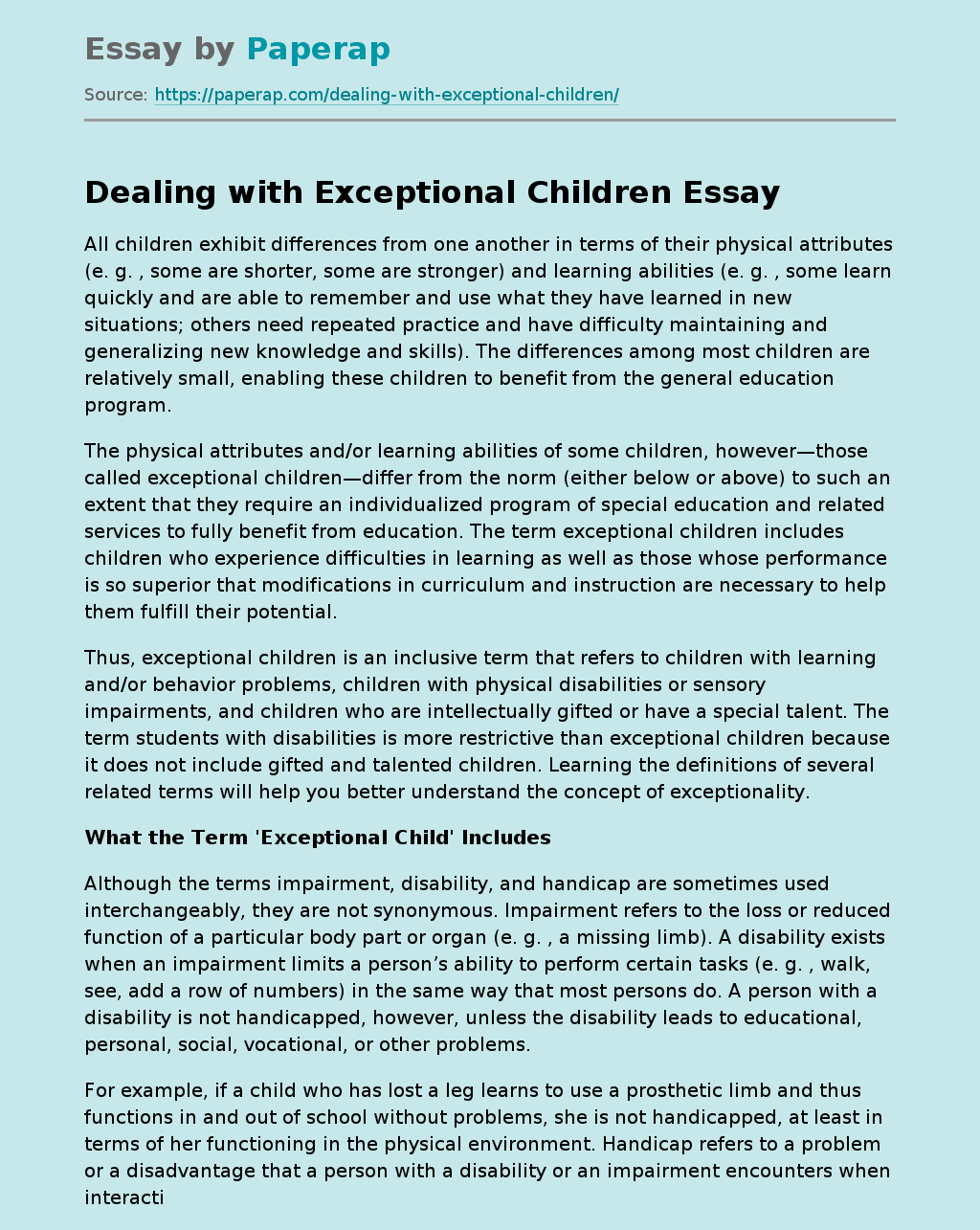Dealing with Exceptional Children
All children exhibit differences from one another in terms of their physical attributes (e. g. , some are shorter, some are stronger) and learning abilities (e. g. , some learn quickly and are able to remember and use what they have learned in new situations; others need repeated practice and have difficulty maintaining and generalizing new knowledge and skills). The differences among most children are relatively small, enabling these children to benefit from the general education program.
The physical attributes and/or learning abilities of some children, however—those called exceptional children—differ from the norm (either below or above) to such an extent that they require an individualized program of special education and related services to fully benefit from education.
The term exceptional children includes children who experience difficulties in learning as well as those whose performance is so superior that modifications in curriculum and instruction are necessary to help them fulfill their potential.
Thus, exceptional children is an inclusive term that refers to children with learning and/or behavior problems, children with physical disabilities or sensory impairments, and children who are intellectually gifted or have a special talent.
The term students with disabilities is more restrictive than exceptional children because it does not include gifted and talented children. Learning the definitions of several related terms will help you better understand the concept of exceptionality.
What the Term ‘Exceptional Child’ Includes
Although the terms impairment, disability, and handicap are sometimes used interchangeably, they are not synonymous. Impairment refers to the loss or reduced function of a particular body part or organ (e.
g. , a missing limb). A disability exists when an impairment limits a person’s ability to perform certain tasks (e. g. , walk, see, add a row of numbers) in the same way that most persons do. A person with a disability is not handicapped, however, unless the disability leads to educational, personal, social, vocational, or other problems.
For example, if a child who has lost a leg learns to use a prosthetic limb and thus functions in and out of school without problems, she is not handicapped, at least in terms of her functioning in the physical environment. Handicap refers to a problem or a disadvantage that a person with a disability or an impairment encounters when interacting with the environment. A disability may pose a handicap in one environment but not in another. The child with a prosthetic limb may be handicapped (i. e. , disadvantaged) when competing against nondisabled peers on the basketball court but may experience no handicap in the classroom.
Individuals with disabilities also experience handicaps that have nothing to do with their disabilities but are the result of negative attitudes and the inappropriate behavior of others who needlessly restrict their access and ability to participate fully in school, work, or community activities. The word handicapped is thought to come from a game that involved a “cap in the hand,” and it has the contemporary meaning of assigning extra weight (a handicap) to better performers to “level” a playing field and enhance wagering (Treanor, 1993).
Unfortunately, the word conjures up the negative image of a person with disabilities begging in the street. In most instances today, the person-first with disabilities is preferred over the term handicapped. At risk refers to children who, although not currently identified as having a disability, are considered to have a greater-than-usual chance of developing one. The term is often applied to infants and preschoolers who, because of conditions surrounding their births or home environments, may be expected to experience developmental problems at a later time.
The term is also used to refer to students who are experiencing learning problems in the regular classroom and are therefore at risk of school failure or of being identified for special education services. Some exceptional children share certain physical characteristics and/or patterns of learning and behavior. These characteristics fall into the following categories of exceptionality: •Mental retardation (developmental disabilities) •Learning disabilities •Emotional and behavioral disorders •Autism •Communication (speech and language) disorders •Hearing impairments Visual impairments •Physical and health impairments •Traumatic brain injury •Multiple disabilities •Giftedness and special talents As stated previously, all children differ from one another in individual characteristics along a continuum; exceptional children differ markedly from the norm so that an individually designed program of instruction—in other words, special education—is required if they are to benefit fully from education. It is a mistake to think that there are two distinct kinds of children—those who are exceptional and those who are regular.
Exceptional children are more like other children than they are different. Nevertheless, an exceptional child does differ in important ways from his peers without disabilities. And whether and how we recognize and respond to those differences will have a major impact on the child’s success in school and beyond. Keep these critical points in mind as you read and learn about the exceptional children described in this text and the special education programs designed to help them.
Dealing with Exceptional Children. (2019, Dec 05). Retrieved from https://paperap.com/dealing-with-exceptional-children/

